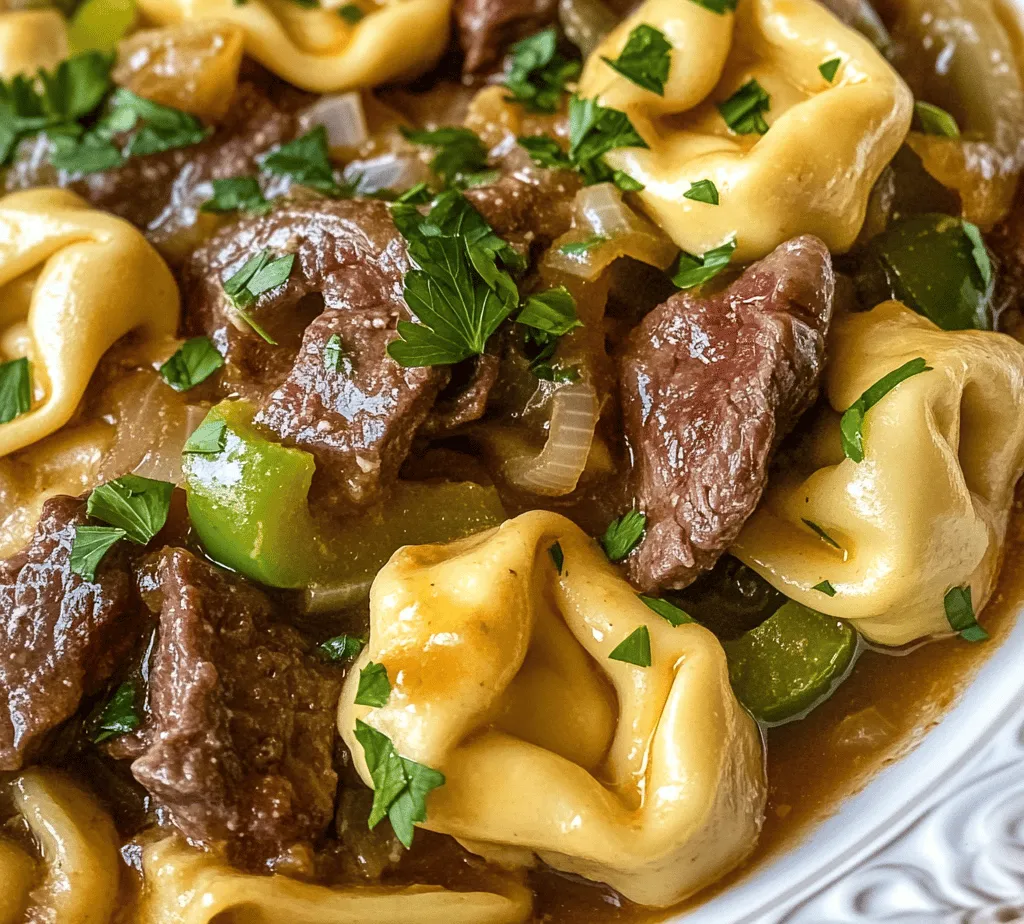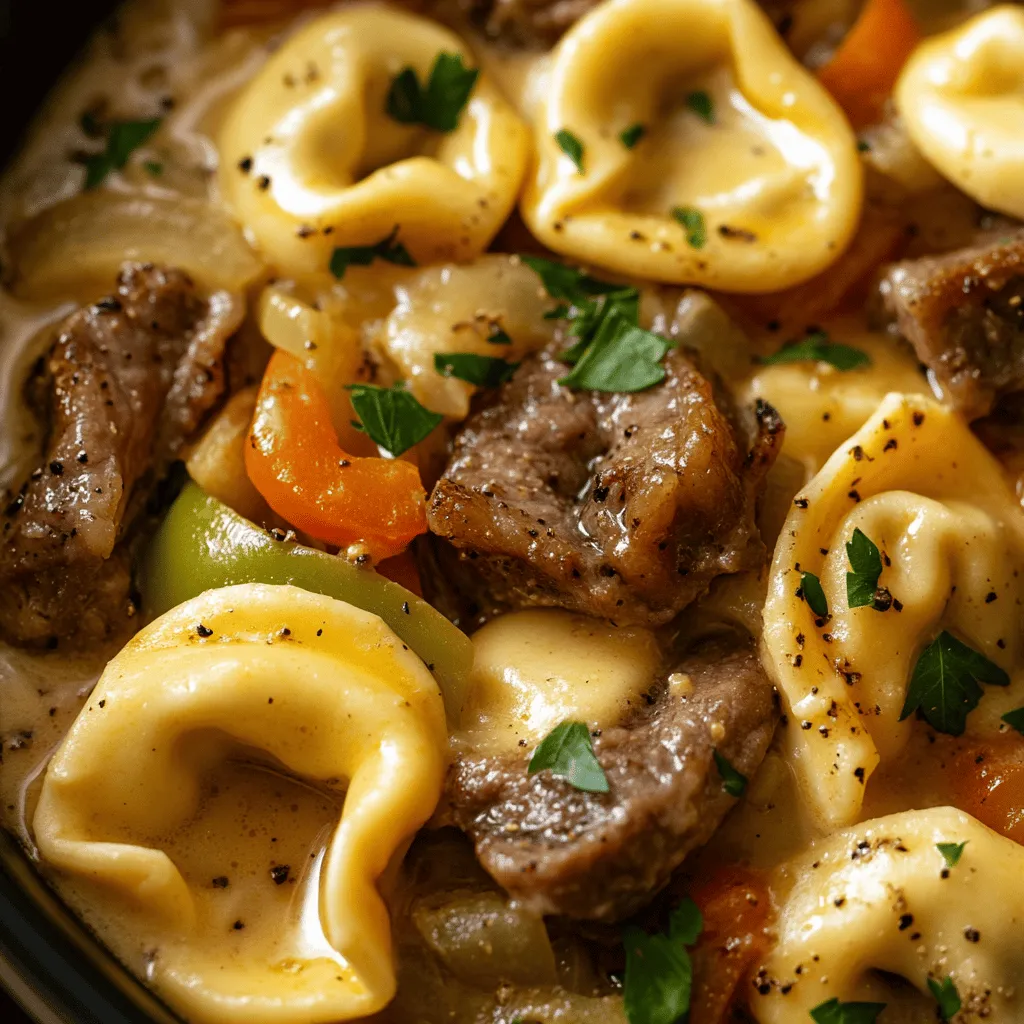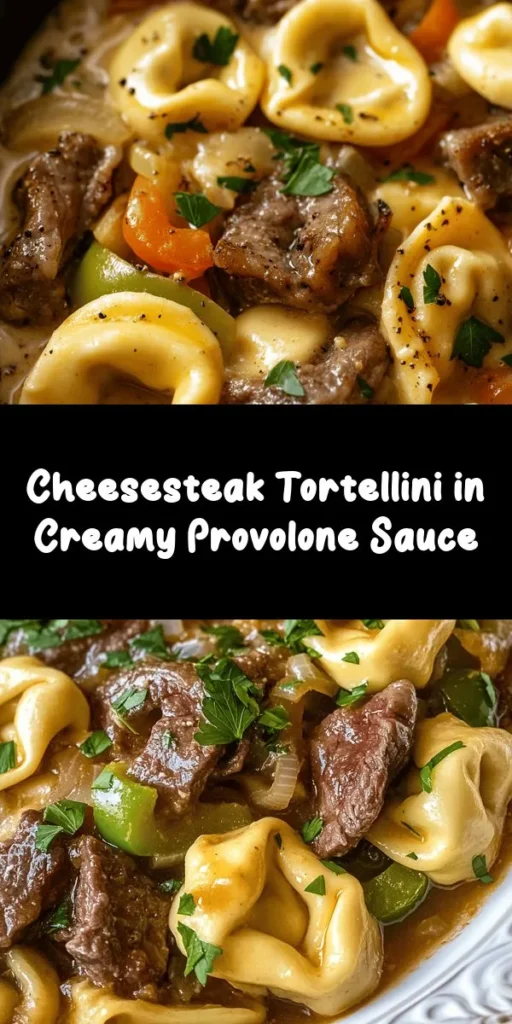Introduction to Cheesesteak Tortellini in Rich Provolone Sauce
In the world of culinary arts, fusion recipes represent a thrilling intersection of flavors and traditions, where classic dishes meet innovative twists. One such mouthwatering creation is the Cheesesteak Tortellini in Rich Provolone Sauce. At first glance, this dish may seem unconventional, but it artfully combines two beloved staples: the iconic cheesesteak and the delightful, pillowy texture of tortellini. The result is a comforting and hearty meal that promises to tantalize taste buds and warm the hearts of all who indulge.
The cheesesteak, a sandwich originating from Philadelphia, is revered for its succulent, thinly sliced ribeye steak, sautéed onions, and gooey cheese, often served on a hoagie roll. On the other hand, tortellini, an Italian pasta, is traditionally filled with cheese, meat, or vegetables, creating a satisfying bite that pairs beautifully with various sauces. By merging these two culinary worlds, Cheesesteak Tortellini not only pays homage to its roots but also transforms them into a new and exciting dining experience.
What truly elevates this dish is the rich provolone sauce that envelops the tortellini and steak, creating a luscious coating that binds the flavors together. Provolone cheese, known for its creamy texture and mild flavor, adds depth to the overall profile, making it an ideal choice for this fusion dish. Whether you’re preparing a cozy family dinner or impressing guests at a special occasion, this recipe is sure to become a favorite, showcasing the best of both worlds in a single, enticing bowl.
Understanding the Key Ingredients
To create a truly memorable Cheesesteak Tortellini in Rich Provolone Sauce, it’s essential to understand the key ingredients that bring this dish to life. Each component plays a significant role in flavor, texture, and overall satisfaction.
Cheese Tortellini: The Star of the Dish
At the heart of this recipe lies cheese tortellini, a delightful pasta that serves as the perfect canvas for the rich sauce and savory fillings. Traditionally hailing from the Emilia-Romagna region of Italy, tortellini is shaped like a small ring and typically filled with a blend of cheese, meat, or vegetables. The most common filling includes a mixture of ricotta, Parmesan, and sometimes even a hint of nutmeg, which adds a subtle warmth to every bite.
When it comes to convenience, using store-bought cheese tortellini is a time-saving option that doesn’t compromise on flavor. These pre-made pasta varieties are widely available in grocery stores and come in various shapes and sizes. If you’re feeling adventurous and have the time, making homemade tortellini can elevate the dish even further, allowing you to customize the fillings and enjoy the freshness of handmade pasta.
Ribeye Steak: A Flavorful Choice
The second star of this dish is the ribeye steak, known for its rich marbling and intense flavor. Ribeye is a prime cut of beef that offers a perfect balance of tenderness and juiciness, making it an excellent choice for cheesesteak-inspired recipes. The marbling of fat within the ribeye not only enhances flavor but also contributes to the overall richness of the dish.
When selecting ribeye for this recipe, look for cuts that are well-marbled and have a deep red color. Freshness is key, so opt for high-quality beef from a trusted butcher or grocery store. To prepare the steak, it’s essential to let it come to room temperature before cooking. This ensures even cooking and maximum tenderness. A simple seasoning of salt and pepper is often all that’s needed to enhance the natural flavors of the ribeye.
Vegetables for Flavor and Texture
No cheesesteak is complete without the addition of sautéed vegetables, which play a crucial role in enhancing the dish’s flavor and texture. Onions and bell peppers are traditional choices that add a touch of sweetness and a delightful crunch. When cooked, these vegetables caramelize, releasing their natural sugars and creating a rich, savory base for the dish.
Using fresh ingredients is paramount for the best results. Opt for sweet yellow onions or red onions, which offer a milder flavor, and choose vibrant bell peppers in shades of green, red, yellow, or orange for a pop of color and sweetness. Chopping the vegetables uniformly ensures even cooking and consistent texture throughout the dish.
The Richness of Provolone Cheese
At the heart of the Cheesesteak Tortellini is the rich provolone cheese, which ties the entire dish together with its creamy, melting properties. Provolone is an Italian semi-hard cheese that comes in various forms, including Provolone Dolce (mild) and Provolone Piccante (sharp). For this recipe, using Provolone Dolce will impart a smooth, buttery flavor that complements the other ingredients.
Provolone cheese has its origins in southern Italy, where it has been produced for centuries. Its unique flavor profile makes it a versatile cheese that pairs beautifully with meats, pastas, and sauces. When melted, provolone achieves a gooey consistency that envelops the tortellini and steak, creating a comforting and satisfying dish.
Crafting the Perfect Sauce
The rich provolone sauce is the pièce de résistance of this recipe, elevating the overall flavor and providing a luscious coating for the tortellini and steak. Crafting the perfect sauce involves a few key steps that will ensure every spoonful is packed with flavor.
Building Flavors: The Cooking Process
The journey to creating the rich provolone sauce begins with sautéing the vegetables. Start by heating a generous amount of olive oil in a large skillet over medium heat. Once the oil is shimmering, add the chopped onions and bell peppers, allowing them to cook until softened and lightly caramelized. This process not only enhances their natural sweetness but also contributes to the overall depth of flavor in the sauce.
One of the critical aspects of cooking is the Maillard reaction, which occurs when proteins in the food react with sugars at high temperatures, resulting in browning and a complex flavor profile. By allowing the vegetables to develop a golden color, you’ll create a flavorful base for the sauce.
Once the vegetables are perfectly cooked, it’s time to deglaze the pan. This technique involves adding a small amount of liquid—such as beef broth or white wine—to the skillet, scraping up any browned bits stuck to the bottom. These flavorful morsels are packed with umami and will enrich the sauce, making every bite more satisfying.
Balancing Creaminess and Depth
To achieve that luxurious sauce that defines Cheesesteak Tortellini, heavy cream and beef broth work together harmoniously. The heavy cream adds a rich, velvety texture, while the beef broth infuses the sauce with a deep, savory flavor. Together, they create a creamy sauce that clings perfectly to the tortellini and steak.
To further enhance the umami profile, a splash of Worcestershire sauce can be added. This condiment, made from fermented anchovies, vinegar, and various seasonings, adds a depth of flavor that elevates the dish and ties all the components together.
Cooking Techniques for Success
To ensure a successful outcome, it’s essential to follow a few cooking techniques closely. When sautéing the vegetables, maintain a steady heat to avoid burning them, and stir frequently to ensure even cooking. When deglazing the pan, use a wooden spoon to scrape up the fond (the browned bits) thoroughly, ensuring that no flavor is left behind.
As you combine the heavy cream and beef broth, stir gently to incorporate all the ingredients without curdling the cream. Allow the sauce to simmer for a few minutes, thickening slightly before adding the grated provolone cheese. Stir until the cheese is fully melted and the sauce is smooth and creamy.
By mastering these techniques and understanding the roles of each ingredient, you’ll be well on your way to creating a delicious Cheesesteak Tortellini in Rich Provolone Sauce that will impress family and friends alike. This dish is not only a feast for the palate but also a testament to the beauty of combining culinary traditions to create something truly special.

Cooking the Tortellini Properly
Cooking tortellini to the perfect al dente texture is crucial for this dish, as it ensures that the pasta maintains its shape and provides a delightful bite. Al dente, which translates to “to the tooth” in Italian, refers to pasta that is cooked until it is firm when bitten. Here are some tips to achieve this ideal texture:
1. Follow Package Instructions: Start by checking the cooking time recommended on the tortellini packaging. Fresh tortellini usually cooks in about 3 to 5 minutes, while dried versions may take longer. Always refer to the manufacturer’s instructions for the best results.
2. Use Plenty of Salted Water: To infuse the pasta with flavor, use a large pot of boiling, salted water. The water should taste like the sea. This not only enhances the flavor of the tortellini but also helps prevent it from sticking.
3. Taste Test: As the cooking time nears its end, taste a piece of tortellini. It should be firm yet tender. If it’s too soft, it may become mushy once combined with the sauce.
4. Shock in Cold Water: If you’re preparing the tortellini in advance, immediately transfer them to a bowl of ice water after draining. This halts the cooking process and helps maintain their texture until you’re ready to mix them with the sauce.
By mastering the art of cooking tortellini properly, you set a solid foundation for the entire cheesesteak tortellini dish.
Searing the Steak to Perfection
Next, let’s focus on searing the ribeye steak, which is crucial for enhancing the dish’s flavor profile. Here’s how to achieve perfectly seared steak:
1. Choosing the Right Cut: Ribeye steak is ideal for this recipe due to its marbling and flavor. Aim for a steak that is at least 1 inch thick for optimal results.
2. Bring to Room Temperature: Before cooking, allow the steak to rest at room temperature for about 30 minutes. This helps it cook evenly.
3. Preheat Your Pan: Use a heavy skillet, preferably cast iron or stainless steel, and heat it over medium-high heat. A properly heated pan is essential for achieving a good sear.
4. Oil and Seasoning: Add a tablespoon of oil with a high smoke point (like canola or avocado oil) to the pan. Season your steak generously with salt and pepper just before placing it in the pan.
5. Searing Time: Sear the steak for approximately 4 to 5 minutes on each side, depending on your desired doneness. For medium-rare, aim for an internal temperature of 130°F (54°C). Use a meat thermometer for accuracy.
6. Avoid Overcooking: To prevent overcooking, avoid moving the steak around too much. Let it form a crust before flipping. Once cooked, remove the steak from the pan and let it rest for about 5 to 10 minutes before slicing. This allows the juices to redistribute, ensuring a juicy bite.
These steps will guide you in achieving a perfectly seared steak that will elevate your cheesesteak tortellini.
Vegetable Sautéing Techniques
The sautéed onions and bell peppers add a delightful sweetness and depth of flavor to your dish. Here’s how to get the best results:
1. Choose Fresh Vegetables: Use fresh bell peppers and onions for the best flavor. Any color of bell pepper—red, green, or yellow—can be used, but red peppers tend to add a touch of sweetness.
2. Slice Evenly: Cut the vegetables into uniform slices to ensure they cook evenly. Aim for thin slices for quicker cooking.
3. Heat the Pan: Use the same pan you seared the steak in, as it will have residual flavor. Heat a little more oil if necessary.
4. Sautéing Process: Add the sliced onions first, as they take longer to soften. Sauté for about 3 minutes until they become translucent. Then add the bell peppers and continue to sauté for another 3-4 minutes.
5. Seasoning: Season the vegetables with a pinch of salt and pepper while they cook. This enhances their natural flavors and helps to draw out moisture.
6. Aim for Tenderness: Cook until the peppers are tender yet still have some crunch. Overcooking can lead to mushy vegetables, which will diminish the overall texture of your dish.
With perfectly sautéed vegetables, your cheesesteak tortellini will have an incredible array of flavors.
Ensuring a Creamy and Smooth Sauce
Creating a rich provolone sauce is the heart of this dish. Here’s how to make sure your sauce is creamy and clump-free:
1. Start with Base Ingredients: Begin by making a roux with butter and flour as a base. Melt 2 tablespoons of butter in the same pan used for the steak and vegetables, then add an equal amount of flour. Stir constantly for about 1-2 minutes to cook the flour slightly.
2. Gradually Add Liquid: Slowly pour in 1 cup of milk or cream while continuously whisking to prevent lumps. Allow the mixture to thicken over low heat.
3. Incorporate Provolone Cheese: Once the sauce has thickened, reduce the heat to low and gradually add shredded provolone cheese. Stir continuously until the cheese is completely melted and the sauce is smooth.
4. Season Throughout the Process: Taste and season the sauce with salt, pepper, and a touch of garlic powder or onion powder for depth. Remember, seasoning should be done at every stage for a well-rounded flavor.
5. Finish with Fresh Herbs: For an added layer of flavor, consider mixing in some fresh chopped parsley or basil at the end.
By following these steps, you’ll create a luxurious sauce that envelops the tortellini and steak beautifully.
Combining Elements for the Final Dish
Now that you have all the components ready, it’s time to bring them together into a delicious dish. Here’s how to combine everything seamlessly:
1. Combine the Tortellini and Sauce: In a large mixing bowl, add the cooked tortellini and pour the creamy provolone sauce over the top.
2. Add the Steak and Vegetables: Then, add the sliced ribeye steak and sautéed onions and peppers to the bowl.
3. Toss Gently: Using a spatula or large spoon, gently fold the ingredients together. Be careful not to crush the tortellini; you want them to retain their shape and texture.
4. Adjust Consistency: If the mixture is too thick, you can add a splash of pasta water or additional cream to reach your desired consistency.
This method ensures that each tortellini is coated with sauce and that the flavors meld beautifully.
Garnishing for Presentation
Presentation is key when serving your cheesesteak tortellini. Here are some garnishing tips to enhance both flavor and visual appeal:
1. Fresh Herbs: Sprinkle freshly chopped parsley or basil over the dish just before serving. This adds a pop of color and a burst of freshness.
2. Parmesan Cheese: Consider grating some extra Parmesan cheese over the top for an additional layer of flavor.
3. Cracked Black Pepper: A light sprinkle of freshly cracked black pepper can enhance the dish’s presentation and flavor profile.
4. Serve in Style: Consider plating the tortellini in a shallow bowl, allowing for a beautiful display of the creamy sauce and vibrant vegetables.
5. Serve with Bread: Accompany the dish with crusty bread or garlic bread to soak up any extra sauce, making it a complete meal.
Nutritional Benefits of Cheesesteak Tortellini
Beyond its delightful taste and comforting qualities, cheesesteak tortellini offers several nutritional benefits worth noting:
Balancing Protein and Carbohydrates
1. Protein Source: Ribeye steak is an excellent source of protein, which is essential for muscle growth and repair. A typical serving provides around 25 grams of protein, making it a fulfilling option.
2. Carbohydrate Energy: Tortellini, while delicious, also serves as a source of carbohydrates, providing energy for daily activities. The balanced combination of protein from the steak and carbohydrates from the tortellini makes this dish a well-rounded meal.
Incorporating Vegetables for Added Nutrition
1. Rich in Vitamins: The inclusion of bell peppers and onions not only adds flavor but also contributes vitamins A and C, which are important for immune function and skin health.
2. Dietary Fiber: Vegetables also provide dietary fiber, which aids in digestion and helps maintain a healthy gut.
3. Colorful Plate: The colorful combination of red, yellow, and green from the vegetables not only looks appealing but also signifies a variety of nutrients.
Conclusion: Enjoying Your Cheesesteak Tortellini in Rich Provolone Sauce
The cheesesteak tortellini in rich provolone sauce is a comforting dish that combines the best elements of classic flavors with a unique twist. Its creamy sauce, tender steak, and flavorful vegetables come together to create a meal that is both satisfying and delicious.
Encourage experimentation with the recipe by trying different types of cheese or adding your favorite vegetables. This dish is perfect for special occasions or cozy family dinners, and it embodies the joy of sharing meals with loved ones.
With each bite, you’ll experience the delightful fusion of flavors that will surely make this dish a staple in your culinary repertoire. So gather your ingredients, embrace the cooking process, and savor the satisfaction of creating something unique and tasty. Enjoy your culinary journey!



